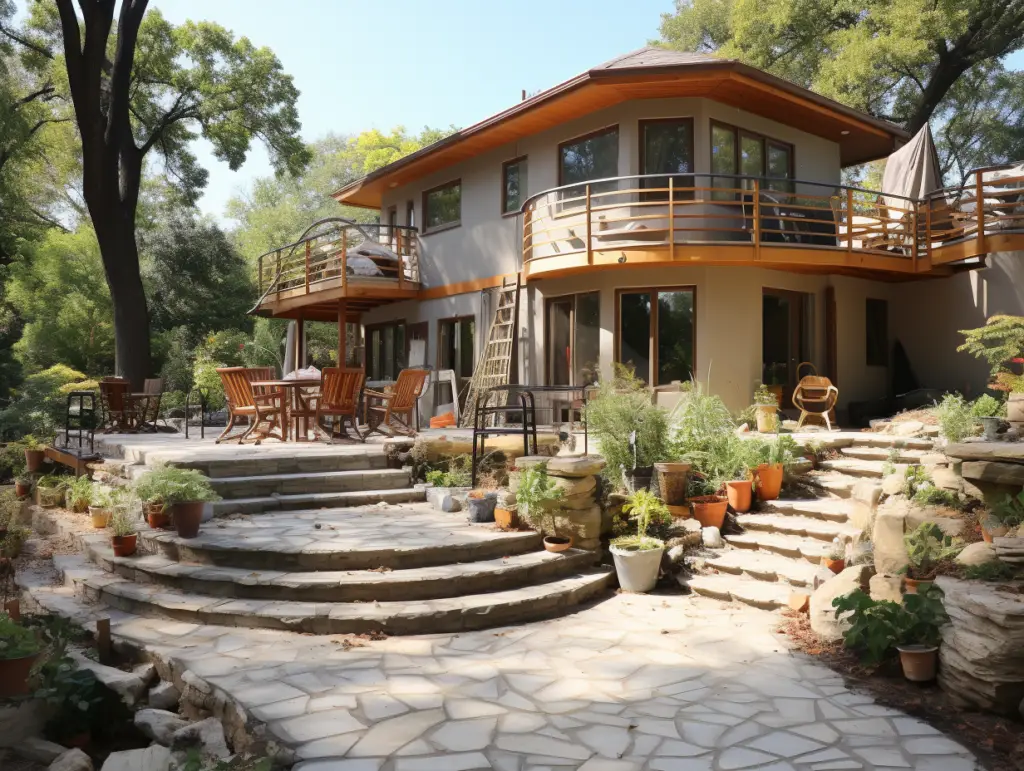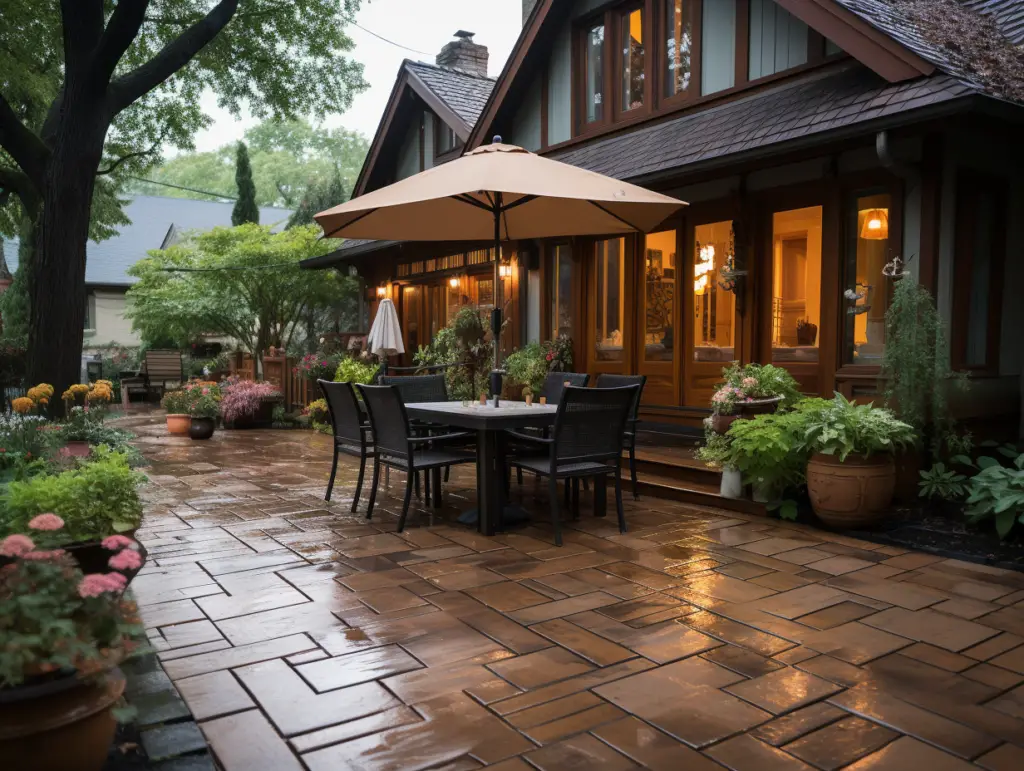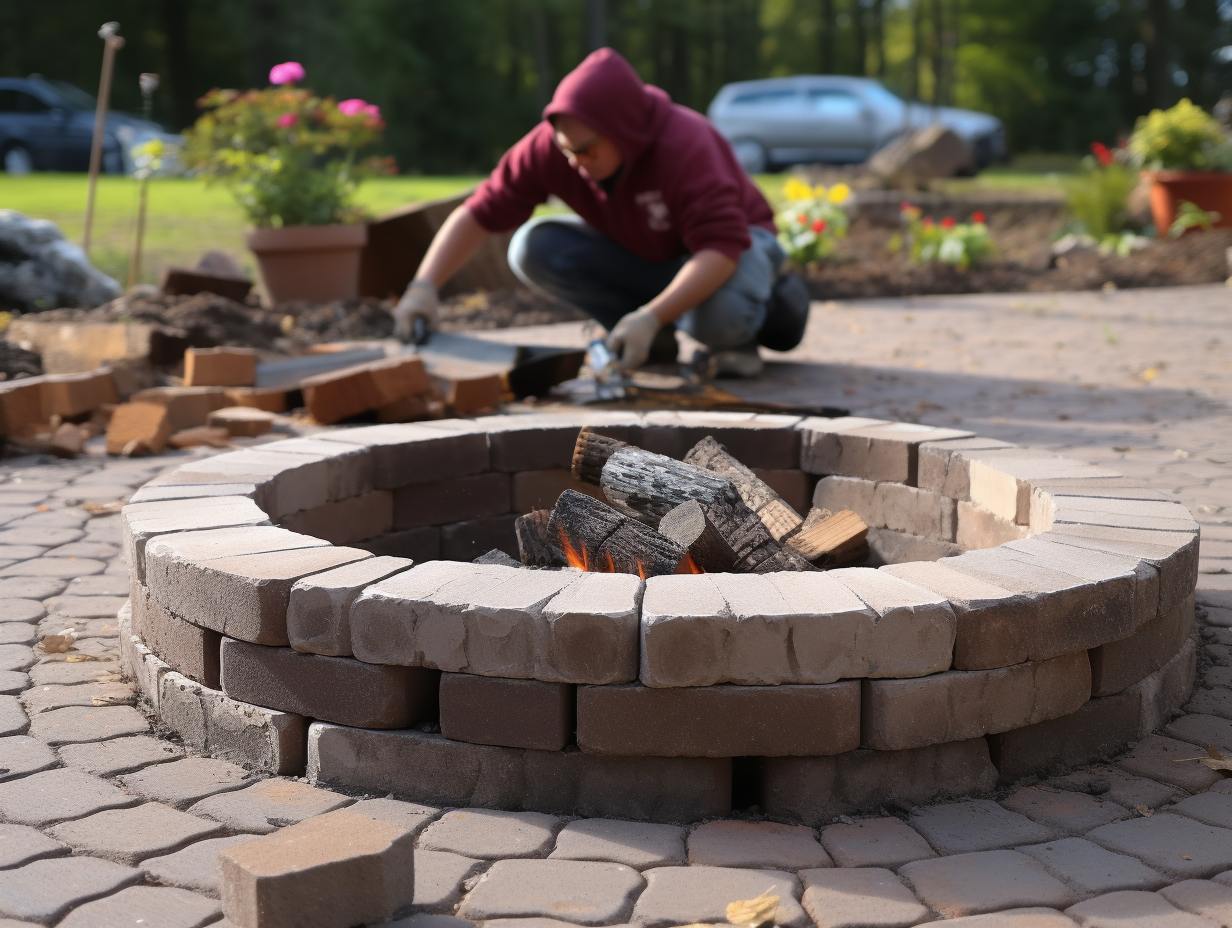Building a patio is an excellent way to add some extra living space and increase your property’s value. However, before you start building, you need to know whether you need a permit to build a patio in California.
The answer is yes, in most cases, you will need a building permit to add nearly any structures to your property, including patios and decks.
Understanding building permits in California is essential before starting any construction project.
According to the California Building Standards Code, no building or structure may be erected, constructed, enlarged, altered, repaired, moved, improved, removed, converted, or demolished unless a separate permit for each building or structure has first been obtained from the building official.
The purpose of building permits is to ensure that the construction project complies with the state’s safety standards and regulations.

Key Takeaways
- Building a patio in California typically requires a building permit.
- Obtaining a building permit is essential to ensure that the construction project complies with the state’s safety standards and regulations.
- There are some exemption cases where you may not need a building permit for patio construction.
Understanding Building Permits in California
If you are planning to build a patio in California, it is important to understand the building permit requirements.
According to the California Building Standards Code, no building or structure may be erected, constructed, enlarged, altered, repaired, moved, improved, removed, converted, or demolished unless a separate permit for each building or structure has first been obtained from the building official.
A building permit is a legal document that grants permission to begin the construction or alteration of a building or structure. The permit process is designed to ensure that the construction work meets the safety standards set forth in the building codes. The building codes are a set of regulations that govern the design, construction, and maintenance of buildings and structures in California.
The permit process is handled by the local building department of the jurisdiction where the project is located. The local government is responsible for enforcing the building codes and issuing the permits.
Each local building department has its own set of requirements and procedures for obtaining a building permit. It is important to contact the local building department for specific information on the permit process.

The California Code of Regulations contains the Building Standards Code, which establishes the minimum requirements for building construction in the state. The Building Standards Code is divided into 12 parts, each covering a different aspect of building construction. The Building Standards Code covers everything from the design and construction of foundations to the installation of electrical systems.
In summary, if you are planning to build a patio in California, you will likely need to obtain a building permit from the local building department. The permit process is designed to ensure that the construction work meets the safety standards set forth in the building codes. It is important to contact the local building department for specific information on the permit process and requirements.
The Need for a Permit for Patio Construction
If you are planning to construct a patio in California, you may be wondering if you need a permit. In most cases, you will need a permit to construct a patio or any other permanent structure in your backyard.

The California Building Code requires that all construction work, including patio construction, be approved and inspected by the local building department. This ensures that the construction work meets the minimum safety standards set by the state.
A permit for patio construction is required for a variety of reasons. Firstly, it ensures that the construction work is safe and meets the minimum safety standards. Secondly, it ensures that the construction work is in compliance with the local zoning laws and building codes.
The need for a permit also depends on the size and location of the patio. If the patio is a significant addition to your home, it may require a plan check and approval from the local building department. Additionally, if you plan to add a patio cover, porch, or pergola, you will need a permit for these structures as well.
Homeowners who construct patios without the necessary permits may face fines and legal consequences. It is essential to obtain the necessary permits before beginning any construction work to avoid legal issues and ensure that the patio is safe and compliant with the local building codes.
In summary, if you plan to construct a patio in California, you will most likely need a permit. Obtaining the necessary permits ensures that the construction work is safe, compliant with the local building codes, and avoids any legal issues.
Permit Requirements for Other Structures and Additions

In addition to patios, there are several other structures and additions that require permits in California. The California Building Standards Code mandates that no building or structure may be erected, constructed, enlarged, altered, repaired, moved, improved, removed, converted, or demolished unless a separate permit for each building or structure has first been obtained from the building official [1].
Some of the other structures and additions that require permits include sheds, fireplaces, decks, pools, spas, walls, garages, fences, retaining walls, patio covers, and carports. Zoning approvals, electrical permits, plumbing permits, HVAC permits, and mechanical permits may also be required depending on the project.
For example, a residential addition to a primary structure, which covers an extension or increase in floor area, number of stories, or height of a structure, requires a permit for new additions and/or remodeling of residential primary structures including a single-family or duplex dwelling, attached apartment, mobile home addition, or RV addition [2].
It is important to note that different cities and agencies may have their own specific code requirements and permit processes.
For instance, in Perris, California, a permit is required for repairing or painting more than 25% of the exterior siding or stucco of a building, as well as for re-roofing, installing ceiling fans, and building one-story detached accessory structures larger than 120 square feet [3].
To ensure that your project complies with all the necessary permit requirements, it is recommended to consult with your local city hall or planning department and obtain the necessary permits before starting any construction or remodeling work. Additionally, inspections may be required at various stages of construction to ensure that the work is being done in accordance with the approved plans and codes.
Overall, it is important to be knowledgeable about the permit requirements for your specific project and to follow them to ensure the safety and legality of your construction or remodeling work.
References
- California Building Permit Requirements
- Residential Building Guide
- Perris Building Permit Information
Understanding the Exemption Cases

In California, building a patio requires a building permit in most cases. However, there are some exemptions that may apply to certain types of work. It is essential to understand these exemptions before starting any patio construction project to avoid any legal issues.
According to the California Building Standards Code, some work is exempt from a building permit. These exemptions are divided into several classes, and each class has specific requirements. For example, one-story detached accessory structures, such as a patio cover, may be exempt from a permit if the floor area is not greater than 120 square feet.
Fences that are not over 7 feet high, retaining walls that are not over 4 feet in height, and water tanks that are not over 5,000 gallons are also exempt from a permit. However, it is important to note that these exemptions have specific requirements, and failure to meet those requirements may result in the need for a permit.
It is also important to note that some types of work may require a permit even if they fall under an exemption class. For example, prefabricated swimming pools require a permit regardless of their size or location.
When it comes to finishing work, such as papering, tiling, and carpeting, a permit is not required unless it involves structural changes or alterations. In such cases, a permit may be required.
In summary, while building a patio in California usually requires a building permit, there are some exemptions that may apply. It is crucial to understand these exemptions to avoid any legal issues. Remember to check the requirements for each exemption class carefully and ensure that you meet them before proceeding with any construction work.
Online Services and Forms for Building Permit Application

If you’re planning to build a patio in California, you will most likely need to obtain a building permit. Fortunately, many California cities and counties offer online services and forms to make the process easier. Here are some resources you can use to apply for a building permit:
Online Services
Many cities and counties in California offer online services that allow you to apply for a building permit from the comfort of your own home. These services typically require you to create an account and provide some basic information about your project. Once you’ve submitted your application, you can track its progress and receive notifications about any updates or changes.
Forms
If you prefer to apply for a building permit in person, you can download the necessary forms from your city or county’s website. These forms typically require you to provide detailed information about your project, including its location, size, and scope. You may also need to provide plans and drawings that show how your patio will be constructed.
Plan Review
Once you’ve submitted your building permit application, it will be reviewed by your city or county’s planning department. This process typically involves a detailed review of your plans and drawings to ensure that your patio meets all applicable building codes and regulations. Depending on the complexity of your project, this review process can take several weeks or even months.
In conclusion, while obtaining a building permit for your patio in California can be a time-consuming process, there are many online services and forms available to help make it easier. By following the guidelines provided by your city or county, you can ensure that your patio is built safely and in compliance with all applicable regulations.
Air Conditioning and Mechanical Systems
When it comes to air conditioning and mechanical systems, permits are required for installation or replacement. This applies to both residential and commercial properties. The California Energy Commission has specific requirements for HVAC systems, including air conditioners and furnaces. These requirements are in place to ensure the safety and efficiency of the system.
To obtain a permit for air conditioning or mechanical systems in California, you will need to submit an application to the local building department. The application will require information such as the type of system, the location of the installation, and the contractor’s license number. Once the application is approved, an inspector will need to visit the property to ensure that the installation meets all safety and building codes.
It is important to note that attempting a DIY installation of an HVAC system without proper licensing is illegal in California. This can result in fines and may pose a safety risk to you and your family. It is always best to hire a licensed contractor to handle the installation or replacement of your air conditioning or mechanical system.
In summary, permits are required for the installation or replacement of air conditioning and mechanical systems in California. It is important to follow all safety and building codes to ensure the safety and efficiency of the system. Hiring a licensed contractor is the best way to ensure that your HVAC system is installed properly and meets all requirements.
Importance of Following Building Regulations
When building a patio in California, it is essential to follow the building regulations set by the state. These regulations are in place to ensure that the construction is safe and meets the code requirements. Failure to follow these regulations can result in penalties, fines, or even legal action.
Building codes are designed to protect the safety of the occupants of a building, as well as the surrounding community. They set standards for construction materials, structural design, and fire safety, among other things. Adhering to these codes ensures that the patio is built safely and will not pose a risk to anyone.
Additionally, obtaining the necessary building permits is required by law in California. Contractors who build without permits may face penalties of up to $5,000 for each violation. Furthermore, the project may be shut down since it will be deemed illegal.
It is also essential to note that not all patio projects will require a building permit in California. However, if the patio is a permanent fixture on the property, it is likely that a permit will be required. Homeowners should consult with their local building department to determine if a permit is necessary.
In conclusion, following building regulations is crucial when building a patio in California. It ensures that the construction is safe and meets the code requirements. Homeowners should obtain the necessary permits and consult with their local building department to ensure that their project is in compliance with the regulations.
Frequently Asked Questions
What happens if you build a patio without a permit in California?
Building a patio without a permit in California can result in hefty fines and legal consequences. Not only can you be fined for building without a permit, but you may also be required to remove the patio altogether. In addition, if you decide to sell your property, you may encounter problems with the title if the patio was built without a permit.
When is a building permit not required for patio construction in California?
In California, a building permit is not required for patios that are not attached to the house and are less than 30 inches above grade. However, it’s important to note that this exemption does not apply to patios that are covered or have a roof.
Do I need a permit for a patio cover in California?
Yes, in California, a permit is required for a patio cover. This is because a patio cover is considered a permanent structure and can affect the safety and stability of your property.
What are the permit requirements for building a patio cover in California?
To obtain a permit for a patio cover in California, you will need to provide detailed plans and specifications of the proposed structure. The plans should include information such as the size and location of the patio cover, the materials to be used, and the method of construction. You will also need to pay a fee for the permit.
Do I need a permit for a paver patio in California?
Yes, in California, a permit is required for a paver patio if it is more than 30 inches above grade or if it is attached to the house. However, if the paver patio is less than 30 inches above grade and not attached to the house, a permit is not required.
How close to the property line can I build a patio in California?
In California, the distance that a patio can be built from the property line depends on the local zoning laws and building codes. In general, the setback requirements for patios are the same as those for other structures on the property. It’s important to check with your local building department to determine the specific setback requirements for your area.




Leave a Reply